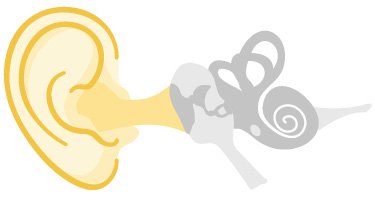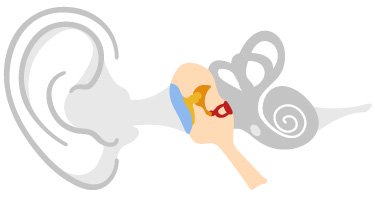Conductive hearing loss means a type of hearing loss that’s caused by damage or obstruction in the outer or middle ear.
This prevents the sound being effectively conducted from the outside world and into the inner ear.
You can get a better understanding of how hearing works in this article about hearing loss.


Conductive hearing loss causes
The causes of conductive hearing loss can be found in two areas: the outer ear and the middle ear.
Because there are many different causes of conductive hearing loss, it can be permanent or temporary.
Outer ear causes of conductive hearing loss:
-
blockage. Anything that blocks the ear canal can cause conductive hearing loss because it hinders sound from reaching the middle ear. A blockage can include impacted ear wax or an obstruction by objects pushed into the canal. This type of conductive hearing loss may not be permanent.
- infection or disease. An infection in the ear canal can block the ear canal and cause conductive hearing loss. Common examples are swimmers’ ear and exostoses (bony growths).
- disorders. Some people are born with congenital disorders such as atresia, where a lack of ear canal development can cause conductive hearing loss. The ear canal can also have stenosis, meaning an abnormal narrowing of the ear canal, which can be congenital or acquired later in life. Some disorders also affect the outer ear, which you can see, and can lead to conductive hearing loss.
Middle ear causes of conductive hearing loss:
- issues with the eardrum. Conductive hearing loss can occur when the eardrum's movements are hindered. Many factors can cause this. These include holes in the eardrum, ear infections, thickening of the eardrum tissue, or imbalances of pressure in the middle ear (too much or too little).
- fluid build-up. Fluid accumulating behind the eardrum can prevent the eardrum from moving and reduce the movement of the middle ear bones. Both problems create conductive hearing loss in the middle ear.
- disarticulation of the middle ear bones. Any damage that causes a disconnection of these three bones from one another can cause conductive hearing loss.
-
disease or disorders. Several middle ear diseases can cause conductive hearing loss, including benign tumors, otosclerosis, or cholesteatomas.
- eustachian tube dysfunction. The eustachian tube connects the middle ear to the back of the throat. It opens and closes to maintain proper pressure in the middle ear or to allow fluid to drain out if needed. When your ears ‘pop’, the opening of this tube releases pressure in the middle ear. If the eustachian tube is blocked, pressure and fluid can build up in the middle ear, causing conductive hearing loss.

Find out more about how hearing works in this article about hearing loss.
Symptoms of conductive hearing loss
If you have conductive hearing loss, you may experience one or more of the following symptoms:
-
pain in one or both ears can signify a problem in the ear and may cause hearing loss
- ears feel plugged or have too much pressure, which cannot be equalized; this can suggest you have a middle ear problem
- muffled sound or difficulty hearing people and sounds around you
- drainage of any liquid coming out of the ear should be evaluated, especially if it has a foul odor or color (yellow, green or pus).
- ringing sounds in your ears, also known as tinnitus
- your own voice sounds louder and unusual
- uneven hearing if your level of hearing is better in one ear.
If you are experiencing any of these symptoms, you should see your doctor and have your hearing tested by your hearing care specialist. Before you book an appointment, you can also test your hearing with an online hearing test, which helps indicate if further steps should be taken.
What’s it like to have conductive hearing loss?
People’s experiences of conductive hearing loss depend on how mild or how severe the hearing loss is.
Mild conductive hearing loss
Many of the soft daily sounds could be missed by someone with mild hearing loss. Soft daily sounds include people breathing, leaves rustling, people whispering, refrigerators humming, cats purring, and water dripping. Although people with mild hearing loss can communicate well in quiet surroundings, in situations with background noise there can be confusion of words starting with certain consonants (“s”, “f” or “th”).
Moderate conductive hearing loss
People with moderate hearing loss have more difficulty hearing and understanding speech at normal conversation levels. Following a conversation requires more effort, and many of the words can be missed or misunderstood, even when it’s quiet. In background noise, it may not be possible to follow a conversation at normal levels. Other sounds that could be missed include laughter, rain falling and coffee brewing.
Moderate-to-severe conductive hearing loss
People with moderate-to-severe hearing loss have difficulty understanding speech in most situations and even more when the situation is noisy. The TV or radio are not understandable at normal levels and require louder volume levels. Other daily sounds that could be missed include water running, an alarm clock, children playing, a busy street, an electric toothbrush and a washing machine.
How do you treat conductive hearing loss?
To treat conductive hearing loss, a general practitioner or ENT (Ear, Nose and Throat) doctor needs to investigate your ears to determine where the conductive loss occurs in your hearing system.
Once they have established the cause and degree of hearing loss, they direct you to the necessary treatment.
Conductive hearing loss can be treated in many cases so that hearing returns to normal or to the level it was before the conductive hearing loss occurred.
If the cause of the hearing loss is permanent, the treatment will involve fitting hearing aids or surgical treatment options such as bone-anchored hearing aids, or middle-ear implants. In the case of conductive hearing loss in both ears (bilateral conductive hearing loss), two hearing aids may be necessary.
Conductive hearing loss treatments
The treatments for conductive hearing loss depend on the cause of the hearing loss. Here are a few examples:
- hearing aids. For a non-surgical solution, a conventional hearing aid can help compensate for transmission loss in conductive hearing loss.
-
extraction. Your physician can remove problems such as impacted ear wax or objects in the ear canal.
- medication. Antibiotics or other medicine can be used to treat various types of ear infections.
- surgical procedure. Abnormalities, tumors, or certain diseases can be treated surgically to repair the damage, such as inserting a patch on the eardrum to cover a hole or removing tumors or diseases such as a cholesteatoma.
- implants. Various implants can help with certain types of middle ear damage. For disarticulated middle ear bones, there is a prosthesis called Total Ossicular Replacement Prosthesis (TORP). There are also bone-anchored hearing aids which are implantable devices that can improve transmission loss.
How does conductive hearing loss differ from sensorineural hearing loss?
Conductive hearing loss is often treatable, unlike sensorineural hearing loss. With conductive hearing loss, the inner ear and hearing nerve function normally.
People with conductive hearing loss generally have difficulty with the overall loudness of sounds, but not the clarity. Therefore, if the volume can be increased sufficiently, they should be able to hear.
The severity of conductive hearing loss falls into one of three categories, instead of five categories as with sensorineural hearing loss:
-
mild conductive hearing loss: 26 to 40 dB HL
- moderate conductive hearing loss: 41 to 55 dB HL
- moderate-to-severe conductive hearing loss: 56 to 70 dB HL.
The farther down your results are on the list, the greater the hearing loss and the more significant the impact on your hearing ability.